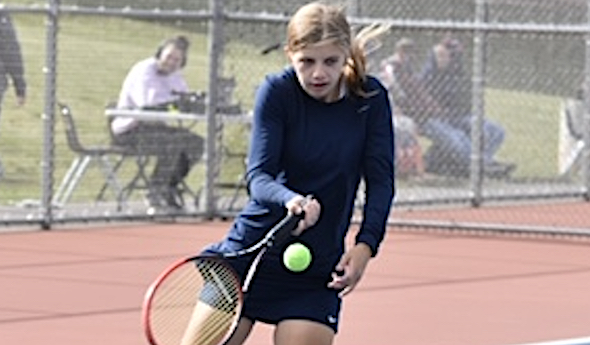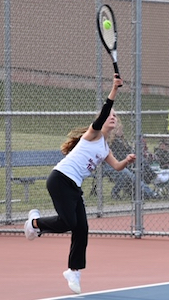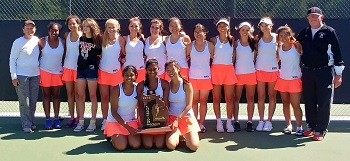
Negaunee Regains Division 1 Supremacy
October 5, 2020
By Ryan Stieg
Special for Second Half
NEGAUNEE – The last 12 months have been a roller coaster ride for the Negaunee girls tennis team.
Last fall, the Miners' dynasty in the Upper Peninsula came to an end at the hands of Marquette after collecting five straight Division 1 titles. Then, like every other tennis team in the state, Negaunee wondered if it would even get a chance at reclaiming its championship thanks to the uncertainty of the COVID-19 pandemic.
However, on Monday, everything fell into place and the Miners climbed back on top of the U.P. with another D1 championship. Negaunee won the Final with 21 points and took five of the eight flight championship matches, leading to a very pleased head coach Kyle Saari.
"I think we're most happy for the girls above anything else," Saari said. "It was a group that went through last year, and they were hungry. But I think it became a learning experience for many of them, and it's a close-knit senior group that I think also made sure to kind of take the juniors underneath their wing too.
"This group, they overcame a lot in spite of the COVID situation, and then they've had a lot thrown at them throughout the course of the year too. You're going to get everybody's best shot. As the year goes on, the more you win, the bigger the target gets. It was nice that they were able to respond on the last day."
 Lexi Mason (No. 3) and Annika Tervo (No. 4) gave the Miners two singles wins, and Negaunee also took three of the four doubles finals. Saari praised Mason, who finished off an impressive undefeated season, along with his No. 1 doubles team.
Lexi Mason (No. 3) and Annika Tervo (No. 4) gave the Miners two singles wins, and Negaunee also took three of the four doubles finals. Saari praised Mason, who finished off an impressive undefeated season, along with his No. 1 doubles team.
"Lexi ended up finishing the season off 19-0, and it's a really quiet 19-0," Saari said. "And it shouldn't be because she truly just lets her game kind of talk for her. She doesn't say much; she's quiet. So I'm tremendously proud of her and the effort she put forth.
“The other unique one is Morgan Carlson and Katelyn Lammi at one doubles. They went through all three of their years undefeated as a doubles team. They're good friends, and they're both good athletes. For them to end their careers 19-0 this year too, it's a unique mark to hit."
Menominee finished second with 14 points at what was supposed to be a seven-team meet, but Escanaba didn't compete. Jenna Nolde (No. 1 singles) and Josie Hofer (No. 2) provided the Maroons' two individual championships.
"I'm proud of my girls," Menominee head coach Nikki Mathieu said. "My one and two singles, they busted their butts this year and they did awesome. I'm proud of them. They're great."
Westwood, which moved up a division after notching four straight Division 2 titles, was third with 10 points. Its lone championship came at No. 4 doubles.
Marquette (eight points), Gladstone (one) and Kingsford rounded out the standings.
PHOTOS: Negaunee’s Lexi Mason returns a volley during the No. 3 singles championship match Monday. (Middle) Menominee’s Josie Hofer serves during her title-clinching win at No. 2 singles. (Photos by Ryan Stieg.)

Redemption Reigns for D1 Champions
June 2, 2018
By John Walker
Special for Second Half
MIDLAND — Bloomfield Hills junior Tia Mukherjee got redemption, while the Northville girls tennis team eked out another title Saturday at the Lower Peninsula Division 1 Finals at the Greater Midland Tennis Center.
Mukherjee dominated for a 6-0, 6-0 win over Northville senior Shanoli Kumar in the championship match at No. 1 singles. Mukherjee lost 6-0, 6-0 last year in the finals to Ann Arbor Pioneer’s Kari Miller, and said that was motivation.
“It feels great after last year,” Mukherjee said. “That was tough. I didn’t want that to happen again. I was more prepared.
“I improved my fitness and my forehand. I did a lot of off-court conditioning. I didn’t have enough energy going into the finals last year.”
Bloomfield Hills coach Chris Dobson agreed.
“Her fitness level is better,” he said. “Plus another year of maturity, poise and confidence. It makes a difference. She was highly motivated coming in.”
“At the end of the day, Tia was amazing,” Northville coach Linda Jones said.
“I thought she is the best player in the state,” Dobson said, “and she proved it. She played her best match and earned it.”
Northville had to earn its title, too, edging Midland Dow 32-30. Bloomfield Hills was third with 28 points.
The Mustangs shared last year’s title with Dow. Dow won the 2016 title. Northville won in 2015. The two were at it again in 2018.
Northville entered Saturday with 24 points and eight players in the semifinals for the first time in school history. Dow had 23 points with seven players, as did Bloomfield Hills.
Northville won key semifinals matches against Dow at No. 2 and No. 3 singles and advanced six to the finals. Dow advanced five, while Bloomfield Hills advanced three and dropped from contention.
 In the finals, Northville and Dow faced off at Nos. 1, 3 and 4 doubles. Dow got the first victory, at No. 3 doubles, and briefly tied the score with a win at No. 2 doubles. But Northville prevailed in the other head-to-head matches, clinching the crown with the win at No. 4 doubles.
In the finals, Northville and Dow faced off at Nos. 1, 3 and 4 doubles. Dow got the first victory, at No. 3 doubles, and briefly tied the score with a win at No. 2 doubles. But Northville prevailed in the other head-to-head matches, clinching the crown with the win at No. 4 doubles.
“It’s so sweet,” Northville’s Jones said. “This year we lost three important seniors and were seeded No. 2 all season behind Dow. We came in as underdogs. The girls just played over their levels. It’s the most satisfying (title). Three-time state champs is not too bad.”
“Absolutely there’s disappointment,” Dow coach Garrett Turner said, “which is a good thing, I guess. It means we’re doing the right things. We win one of those matches and the nerves are shifted to them. It’s hard to be upset with a second-place finish. We had our chances.”
At No. 2 singles, Ann Arbor Huron junior Miriam Gandam, the No. 1 seed, defeated Northville sophomore Tori Mady, the No. 2 seed, 2-6, 6-0, 6-1. Mady, the 2017 champ at No. 4 singles, got a key semifinals win over Dow’s Zoe Angell, 7-6 (3), 6-1.
At No. 3 singles, Ann Arbor Skyline senior Caroline Cartwright, the No. 2 seed, defeated Northville junior Renee Torres, the No. 4 seed, 6-3, 6-2. Torres, the returning champ at No. 3 singles, upset Dow’s Sarah Ismail, the No. 1 seed and returning champ at No. 2 singles, in a key semifinal match, 6-3, 6-4.
At. No. 4 singles, Jenna Silverman, the No. 1 seed, rallied past Dow senior Hadley Camp, 3-6, 6-4, 7-6 (1) in a 2-hour, 57-minute match. Silverman also rallied for a 4-6, 6-4, 6-2 win in the semifinals over Northville’s Maya Mulchanandani. Camp was the Finals runner-up for the third straight year.
At No. 1 doubles, Northville senior Serena Wang and junior Sophie Zhuang, the No. 1 seed, defeated Dow seniors Tatum Matthews and Kelly Livingston, the No. 2 seed, 6-1, 6-4.
At No. 2 doubles, Dow junior Meghan Killmaster and sophomore Victoria Leiti, the No. 3 seed, defeated Bloomfield Hills senior Alandria Bellamy and sophomore Kaela Bernard, the No. 4 seed, 6-2, 6-2.
At No. 3 doubles, Dow seniors Giacomina Fabiano and Christina Vanderkelen, the No. 3 seed, defeated Northville junior Madison DeYoung and freshman Michelle Tong, the No. 4 seed, 6-2, 6-3.
At No. 4 doubles, Northville junior Connie Gao and freshman Sneha Ganan, the No. 2 seed, defeated Dow juniors Amelie Kraef and Reema Patel, the No. 1 seed, 6-4, 7-6 (1). Kraef and Patel came into Saturday without losing a set all season but had to rally for a 5-7, 6-1, 7-5 win in the semifinals.
PHOTOS: (Top) Bloomfield Hills' Tia Mukherjee prepares to return a shot during her No. 1 singles match Saturday. (Middle) Northville poses with its latest MHSAA Finals trophy. (Click to see more from HighSchoolSportsScene.com.)

